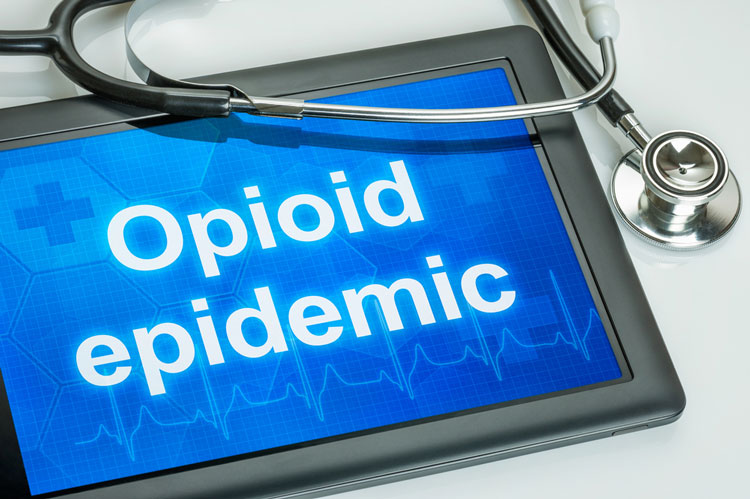Opioid overdose deaths are skyrocketing during the COVID-19 pandemic. Author Jennie Burke movingly wrote of her brother’s death from a heroin overdose in May 2020, noting that he was just one of thousands who died of an opioid overdose during the midst of the pandemic. The internal isolation and loneliness he suffered during a period of time of required physical isolation only compounded the multiple factors that led to his early demise at age 43.
Compelling data show that 2020 will be the worst year yet for opioid overdoses. (Opioids include heroin, methadone, codeine, fentanyl, and other drugs derived form the poppy plant.) According to the NIH, there were 48,802 opioid overdose deaths in 2018 due to either prescription or illegal opioid use—about 133 deaths per day. And according to the CDC, during the 12 months ending in May 2020, there were 81,000 drug overdose deaths reported—the highest ever reported during a 12-month period of time. This equates to 222 deaths a day, which means there has been an increase of 67% in overdose deaths compared to those in 2018. The pandemic has affected much of the progress made in recent years to decrease opioid overdoses. In 2019, the focus of the opioid epidemic was a major topic of discussion toward policy solutions, and Sweeney writes that it feels like, “We may need to start the ball rolling again.”
Sweeney also notes that factors of the pandemic that have worsened the opioid crisis for anyone struggling with substance use disorder include loss of jobs, limited social and family interactions, depression and anxiety stemming from the pandemic, and the removal of attention by media, legislators, and public health agencies. In addition, the pandemic can be the trigger that causes someone to end up becoming an addict.
High-risk populations
As in Jennie’s brother’s case, opioid overuse is a complex problem with multiple risk factors. Housing insecurity, homelessness and incarceration can be potential outcomes of opioid use disorders, according to the Indian Health Service. Facilities where large groups of individuals are in close contact like homeless shelters, jails and prisons are high risk for COVID-19 submission.
Opioid use affects respiratory health and makes opioid users more susceptible to the coronavirus. An article published by Northeastern State University (NSU) notes that patients who are assessed as having adverse childhood experiences such as emotional and physical abuse may be at higher risk to use illegal drugs and prescription pain medication in the future. Finally, newborns who are exposed to opioids in utero suffer withdrawal symptoms after birth.
Federal partner recommendations and responses
In response to the challenges of the COVID-19 pandemic, federal partners are working to help and support communities responding to the opioid overdose crisis and are putting several initiatives in place.
In December of 2020, the CDC issued a health advisory to medical health professionals, first responders, harm reduction organizations, and various community partners recommending the following actions:
- expand distribution and use of naloxone and overdose prevention education
- expand awareness about and access to and availability of treatment for substance use disorders
- intervene early with individuals at highest risk for overdose
- improve detection of overdose outbreaks to facilitate more effective response.
Other actions include:
- The Centers for Medicare and Medicaid Services has expanded COVID-19 telehealth services for reimbursement through Medicare.
- The Substance Abuse and Mental Health Services Administration recommends the use of outpatient treatment options due to the potential risk of coronavirus spread in inpatient or residential facilities.
- The Drug Enforcement Administration (DEA) has waived in-person visits before controlled substance prescribing for the treatment of opioid use disorders. The DEA also has expanded availability of newer long-acting buprenorphine for some patients who have stabilized on daily dosing.
Naloxone saves lives
Naloxone is used to reverse the respiratory depression effects caused by an overdose of opioids. It’s available over-the-counter in most states and as a prescription drug in others under the brand names Narcan and Evzio. Naloxone administration options are injectable, auto-injectable, and nasal spray.
Through various agencies and public health departments across the United States, individuals may be able to access free naloxone training and receive free naloxone. For example, those with drug addiction or their loved ones can learn how to obtain free naloxone by visiting National Harm Reduction Coalition’s website (harmreduction.org/resource-center/harm-reduction-near-you/). In addition, some counties provide free naloxone training and kits. For example, the public health services district office in Coconino County, Arizona, offers a free naloxone training and distribution program for community members.
Nurses can help minimize the opioid crisis
The NSU article notes that nurses practice in a wide range of healthcare settings, which puts them in a unique position to respond to the opioid crisis. For example, they can identify early signs of opioid misuse. The article outlines several strategies:
- Nurses can provide education to postoperative patients about ensuring prescription opioids are kept in a safe place. This action helps to dissuade individuals within the same household who are not legally prescribed the opioid.
- Nurses can supply community resources for patients who have a history of substance abuse disorders, such as free naloxone.
- Nurses can provide a new “common sense” approach to treating newborns experiencing opioid withdrawal – gauging whether the baby can eat, sleep and be consoled within 10 minutes before providing medication to wean them off exposure. This process may safely reduce the hospitalization stay required.
- Nurses can demonstrate compassion and empathy when caring for those with additions, who often carry tremendous shame.
The article concludes with some good news: Both recovery and prevention of opioid overuse are possible with proper care and attention.
Mary Gemma O’Donnell is an assistant clinical professor at the Northern Arizona University School of Nursing in Flagstaff, Arizona. She is a certified American Heart Association BLS Provider trainer, which includes training of Opioid Associated Life-Threatening Emergencies.
References
Burke J. Overdose deaths are skyrocketing during the pandemic. My brother was one of them. HuffPost. July 24, 2020. huffpost.com/entry/drug-overdose-covid-19-pandemic_n_5f18413cc5b6296fbf3c16c0
CDC. Overdose deaths accelerating during COVID-19. December 17, 2020. cdc.gov/media/releases/2020/p1218-overdose-deaths-covid-19.html
Coconino County Arizona. Opioid overdose prevention and crisis response program. n.d. coconino.az.gov/2040/Prescription-Drug-Overdose-Prevention-Pr
Indian Health Services. Opioids and the COVID-19 pandemic. n.d. ihs.gov/opioids/covid19/
Narcan uses, side effects & risk factors. Addiction Group. August 2, 2021. addictiongroup.org/drugs/prescription/narcan/
Northeastern State University. Nurses can help minimize opioid crisis. October 18, 2018. nursingonline.nsuok.edu/articles/rnbsn/nurses-help-minimize-opioid-crisis.aspx
Sweeney C. A crisis on top of a crisis: COVID-19 and the opioid epidemic. Harvard T.H. Chan School of Public Health. February 16, 2021. hsph.harvard.edu/news/features/a-crisis-on-top-of-a-crisis-covid-19-and-the-opioid-epidemic/


















